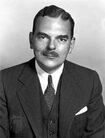| |||||||||||||||||||||||||||
| |||||||||||||||||||||||||||
| |||||||||||||||||||||||||||
The U.S. presidential election of 1944 was the 40th quadrennial presidential election. It was held on Tuesday, November 7, 1944. This election was the first presidential election held in the U.S. after the Second Great War.
The Candidates[]
Incumbent President Charles W. La Follette had ascended to the office in 1942, when a Confederate bombing raid on Philadelphia killed his predecessor, Al Smith. He maintained a hands-off policy during the war, allowing the might of the U.S. military to be fully brought to bear against the C.S. which brought about a decisive U.S. victory.
Thomas Dewey had made a name for himself as a crusading prosecutor in New York.
The Campaign[]
On paper, La Follette's role as victorious president should have given him an easy victory when he ran in his own right. La Follette ran on a promise of reintegrating the C.S. states into the Union, as well as the promise of the country's continued dominance on the North American continent.
Despite La Follette's sturdy leadership and complete U.S. victory, Dewey and the Democratic Party campaigned on the idea that complacency and appeasement under the Socialist Party had made the rise of Jake Featherston and the attack on the United States possible. Dewey asserted that he would be far better suited to keep the peace now that the Socialists had won the war.
The Election[]
Although La Follette and his supporters correctly pointed out that Featherston and the C.S. had made substantial gains under Democrat Herbert Hoover, Dewey's campaign appealed to the voters. And so for second time in U.S. history, an incumbent president was voted out of office in spite of a tremendous military victory over the Confederate States. Further, La Follette lost votes to the earnest young Republican Governor of Minnesota, who took not only Socialist stronghold of Minnesota, but La Follette's home state of Wisconsin as well. The Republicans also took the states of Indiana and Kansas.
The Democratic victory was a surprise to the Chicago Tribune, which had prepared headlines the night of the election proclaiming "La Follette beats Dewey".
OTL Election[]
The historical 1944 election also featured Thomas Dewey as a presidential candidate and Harry Truman as a vice-presidential candidate, but on different tickets. Dewey emerged as the Republican Party's nominee from a crowded field. Harold Stassen launched his first presidential campaign this year; he would launch his final one in 1992, and he never did secure the Republican nomination.
Truman joined incumbent Franklin D. Roosevelt, replacing incumbent VP Henry Wallace at the insistence of more conservative elements in the Democratic Party, who were concerned about Roosevelt's health.
Despite Roosevelt's popularity, which was continually being buoyed by news of major battlefield victories such as Leyte Gulf, Dewey came closest of any of Roosevelt's four opponents to defeating him.
Roosevelt died on April 12, 1945 from a cerebral hemorrhage and Truman served most of the term. Truman ran for reelection in 1948 with Alben Barkley and Dewey was the Republican candidate once again, this time running with Earl Warren. Dewey would come even closer to defeating the far less popular Truman (close enough for the Chicago Tribune to run its infamous headline "Dewey Defeats Truman", which Harry Turtledove echoed in his version of the 1944 election), but he would lose that election as well.
See Also[]
| |||||||||||||














